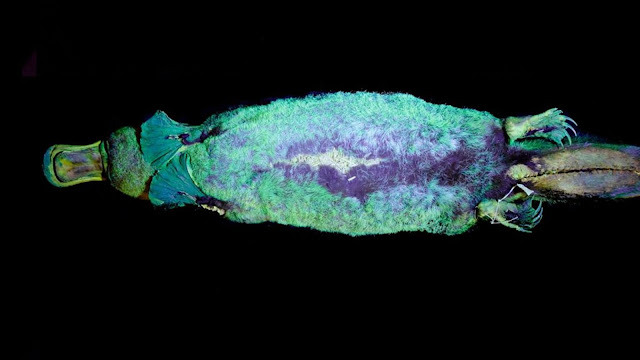Platypus fur glows green under UV light, scientists discover
How unique is the platypus? Let us count the ways: It is one of the only mammals which lays eggs, it is venomous, it senses prey using electrolocation, and - as scientists have just discovered - it glows green under ultraviolet light.
Biofluorescence - when light is absorbed and then emitted at a different wavelength - is exceptionally rare in mammals although it occurs in many kinds of reptiles, fish and amphibians.
Before the platypus discovery, published recently in the journal Mammalia, this bizarre trait had only been seen in flying squirrels and opossums.
Platypus milk could save lives. Pic: Laura Romin and Larry DaltonThe platypus belongs to a group of mammals called monotremes, which lay eggs from which their young hatch, although as all mammals do - these young are then nursed with milk.
Monotremes are "an ancient mammalian lineage with a long independent evolutionary history" according to the researchers from Northland College in the US, which is part of the reason why the platypus is so unique.
Indeed, according to research published back in 2018, the platypus' biochemistry is so unique that its milk contains a new protein with antibacterial properties that scientists believe could be used to treat antibiotic-resistant infections.
One of the paper's authors had previously discovered that flying squirrels glowed pink under ultra-violet light by accident, while they were searching for lichens at night.
Evolution of the Platypus, Moth Light Media, Apr 30, 2020
Although the three animals are from different mammal lineages - from the egg-laying platypus, to the marsupial opossum, and the placental flying squirrel - they are all most active during the night and at dawn.
The researchers suggest that these animals "and possibly others developed biofluorescence to adapt to low light conditions" and be visible to each other in the dark.
"It was a mix of serendipity and curiosity that led us to shine a UV light on the platypuses at the Field Museum," said lead author Professor Paula Spaeth Anich, of Northland College.
"But we were also interested in seeing how deep in the mammalian tree the trait of biofluorescent fur went.
"It's thought that monotremes branched off the marsupial-placental lineage more than 150 million years ago. So, it was intriguing to see that animals that were such distant relatives also had biofluorescent fur," Professor Anich added.
The team, which based their study on animal remains in museums, now aim to partner with scientists in Australia to see if they can find platypuses in the wild which also glow.




No comments:
Post a Comment
Stick to the subject, NO religion, or Party politics